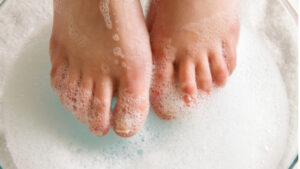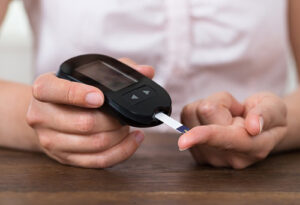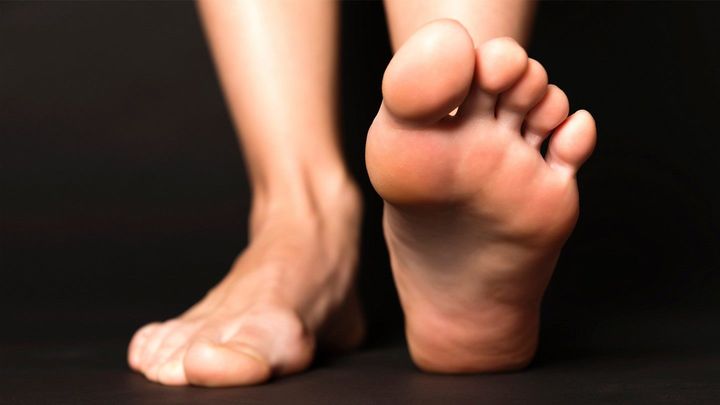One of the biggest risks for people living with diabetes is developing a foot infection. This can often lead to hospitalization and even amputation. In this blog post, we will discuss 11 steps that you can take to reduce your risk of developing a diabetic foot infection. Follow these tips and you will be on your way to keeping your feet healthy and infection-free!
Contents
- 1 What Is Diabetic Foot?
- 2 What Causes Diabetic Foot?
- 3 11 Steps to Reduce the Risk of Diabetic Foot Infections
- 3.1 Wash your feet every day
- 3.2 Check your feet for cuts, blisters, or redness
- 3.3 Do not walk barefoot
- 3.4 Wear shoes and socks that fit well
- 3.5 Avoid hot water baths and long showers
- 3.6 Keep your skin moisturized
- 3.7 Do not smoke
- 3.8 Visit your doctor regularly
- 3.9 Maintain a healthy blood sugar level
- 3.10 Wear proper footwear when exercising
- 3.11 Try to avoid injury to your feet
- 4 Conclusion
What Is Diabetic Foot?
 The diabetic foot is a foot that has been damaged by diabetes. Diabetes can damage the nerves and blood vessels in your feet, which can lead to infections and ulcers. If you have diabetes, it is important to take care of your feet and see a doctor if you develop any problems.
The diabetic foot is a foot that has been damaged by diabetes. Diabetes can damage the nerves and blood vessels in your feet, which can lead to infections and ulcers. If you have diabetes, it is important to take care of your feet and see a doctor if you develop any problems.
Symptoms
There are several symptoms of a diabetic foot infection. These include:
- Redness, swelling, or warmth in your foot.
- Pain or tenderness in your foot.
- A blister or sore on your foot that does not heal.
- Foul-smelling drainage from your foot.
- Feeling like there is something “crawling” under your skin.
These symptoms can be a sign of a serious infection. If you have any of these symptoms, you should see a doctor right away.
What Causes Diabetic Foot?
When it comes to diabetic foot, there are several different things that can cause an infection. These include:
Poor circulation
Poor circulation is one of the most common causes of diabetic foot. When you have diabetes, your body is not able to properly circulate blood. This can cause a build-up of sugar in your blood, which can lead to an infection. It is important to keep your circulation as healthy as possible to prevent an infection.
Wounds or sores
If you have any wounds or sores on your feet, it is important to keep them clean and dry. If you have diabetes, your body is not able to fight off infection as well as a non-diabetic person. This means that any wounds or sores can become infected easily. It is important to check your feet regularly for any cuts or scrapes.
Nerve damage
Diabetes can also cause nerve damage. This is called diabetic neuropathy. When you have this, you may not be able to feel your feet as well. This means that you may not know if you have a cut or scrape. It is important to check your feet regularly for any wounds or sores. This can help you avoid an infection.
Calluses and blisters
If you have diabetes, you may also be at risk for calluses and blisters. These can be caused by the pressure of your shoes on your feet. They can also be caused by walking or standing for long periods of time. Calluses and blisters can become infected easily. It is important to check them regularly and to keep them clean and dry.
Trauma to the foot
Trauma to the foot is another common cause of diabetic foot. This can be caused by something as simple as a stubbed toe. When you have diabetes, your body is not able to heal as quickly. This means that any trauma to your foot can lead to an infection. It is important to be careful and to avoid any trauma to your feet.
Fungal infections
Fungal infections are another type of infection that can occur in people with diabetes. These are usually found in warm, moist areas. They can also be found on the toenails. Fungal infections can be difficult to treat and can lead to other problems if they are not treated properly. When you have diabetes, it is important to see a doctor if you think you may have a fungal infection.
Bacterial infections
Bacterial infections are the most common type of infection that can occur in people with diabetes. They are usually found in wounds or sores. Bacterial infections can be treated with antibiotics. However, if they are not treated properly, they can lead to other problems like sepsis. You should see a doctor if you think you may have a bacterial infection.
Improperly fitting shoes
If you have diabetes, it is important to wear shoes that fit properly. Shoes that are too tight or too loose can cause problems. They can rub on your feet and cause wounds. They can also cause calluses and blisters. This can lead to an infection and other problems. It is important to get your feet measured and to buy shoes that fit properly.
These are just a few of the things that you can do to reduce the risk of a diabetic foot infection. You should always talk to your doctor about your risks and what you can do to reduce them. They can help you develop a plan to keep your feet healthy and reduce your risk of infection.
11 Steps to Reduce the Risk of Diabetic Foot Infections
Now that you know how important it is to take care of your feet if you have diabetes, here are 11 steps you can take to reduce your risk of foot infections:
Wash your feet every day
 Washing your feet is one of the best ways to reduce the risk of infection. This is because it helps to remove any dirt, debris, or bacteria that could be on your feet. You should wash your feet with warm water and soap. Be sure to dry them completely afterward so that they do not stay wet.
Washing your feet is one of the best ways to reduce the risk of infection. This is because it helps to remove any dirt, debris, or bacteria that could be on your feet. You should wash your feet with warm water and soap. Be sure to dry them completely afterward so that they do not stay wet.
Check your feet for cuts, blisters, or redness
You should check your feet every day for any cuts, blisters, or redness. These may be signs of an infection. If you see anything, you should clean it with warm water and soap. You should then put a bandage on it to keep the area clean and dry.
Do not walk barefoot
Walking barefoot can increase your risk of injury. When you walk barefoot, you are more likely to stub your toe or step on something sharp. This can lead to an infection. It is important to always wear shoes that fit properly.
Wear shoes and socks that fit well
It is important to wear shoes and socks that fit well. Shoes that are too tight or too loose can cause problems. While you are wearing them, they can rub on your feet and cause wounds. This can lead to an infection and may even require you to have surgery.
Avoid hot water baths and long showers
Hot water can dry out your skin. This can make it more likely to crack and bleed. When this happens, you are at a higher risk for infection. It is important to avoid hot water baths and long showers. Instead, take short showers with warm water.
Keep your skin moisturized
Skin that is dry is more likely to crack and bleed. That is why it is important to keep your skin moisturized. You can do this by using a lotion or cream every day. Try to find one that is unscented and hypoallergenic.
Do not smoke
Smoking can decrease the blood flow to your feet. This should already be a reason to quit, but it is also important for your foot health. When you smoke, you are more likely to develop an infection or other problems with your feet.
Visit your doctor regularly
If you have diabetes, it is important to visit your doctor regularly. They will check your feet for any problems. They can also help you develop a plan to keep your feet healthy. It is important to follow their advice so that you can reduce your risk of infection.
Maintain a healthy blood sugar level
 Blood sugar that is not well controlled can lead to problems with your feet. When your blood sugar is high, it can damage the nerves in your feet. This can lead to wounds that are slow to heal. It is important to maintain a healthy blood sugar level so that you can reduce your risk of infection.
Blood sugar that is not well controlled can lead to problems with your feet. When your blood sugar is high, it can damage the nerves in your feet. This can lead to wounds that are slow to heal. It is important to maintain a healthy blood sugar level so that you can reduce your risk of infection.
Wear proper footwear when exercising
If you are going to exercise, it is important to wear proper footwear. This will help to protect your feet from any injuries. It is also important to avoid walking or running on hard surfaces. This can cause wounds that are slow to heal.
Try to avoid injury to your feet
If you injure your foot, it is important to see a doctor right away. This is because an injury can lead to an infection. It is also important to avoid walking on your foot until it has healed. When you do walk, you should wear shoes that fit well and provide support.
These are just a few of the things that you can do to reduce your risk of developing a foot infection. If you have diabetes, it is important to take extra care of your feet. By following these tips, you can help to keep your feet healthy and avoid any problems.
Conclusion
In conclusion, by following the 11 steps above you can significantly reduce your risk of developing a diabetic foot infection. However, it’s important to remember that even if you do everything right, infections can still occur. That’s why it’s critical to see your doctor regularly and at the first sign of any redness, swelling, or drainage from your feet. Remember, diabetic foot infections can be very serious and even life-threatening, so don’t delay in getting the treatment you need.
For more such information on Diabetes care, consider contacting Mantra Care. Our team of experts can help you manage your diabetes and improve your overall health with our Diabetes Control Program. You can also get in touch with their nutrition experts through our online nutrition counseling, who can guide you through the process and help you achieve your fitness goals.


